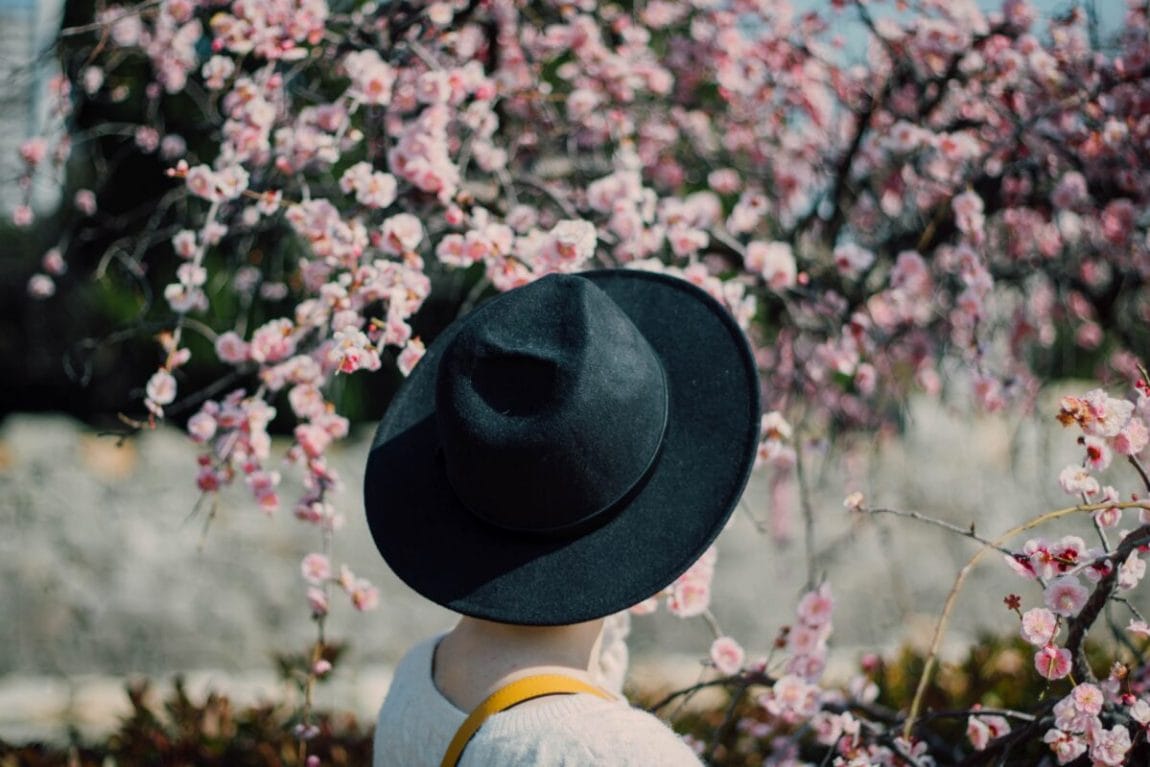Perhaps nowhere else in the world takes the observation of natural beauty as seriously as Japan. Every spring, from late March to early April, a cultural and natural phenomenon is blooming in the Land of the Rising Sun. Hanami, or flower viewing, is the ancient practice of witnessing the overwhelming beauty of sakura or ume, flowering trees that awe and delight, heralding in a new spring. Almost 3 million visitors descend on Japan to witness these burgeoning beauties, starting in the month of March.
Hanami literally translates to “flower viewing”, a term that is typically reserved for cherry blossoms but also applies to plum blossoms, and a variety of other flower spectacles you can see in Japan. Hanami dates back hundreds of years to the Nara Period, between 710 and 784 CE. The first flower viewing parties were conducted by the royal family, but their appreciation quickly spread to the masses, resulting in huge hanami parties today.
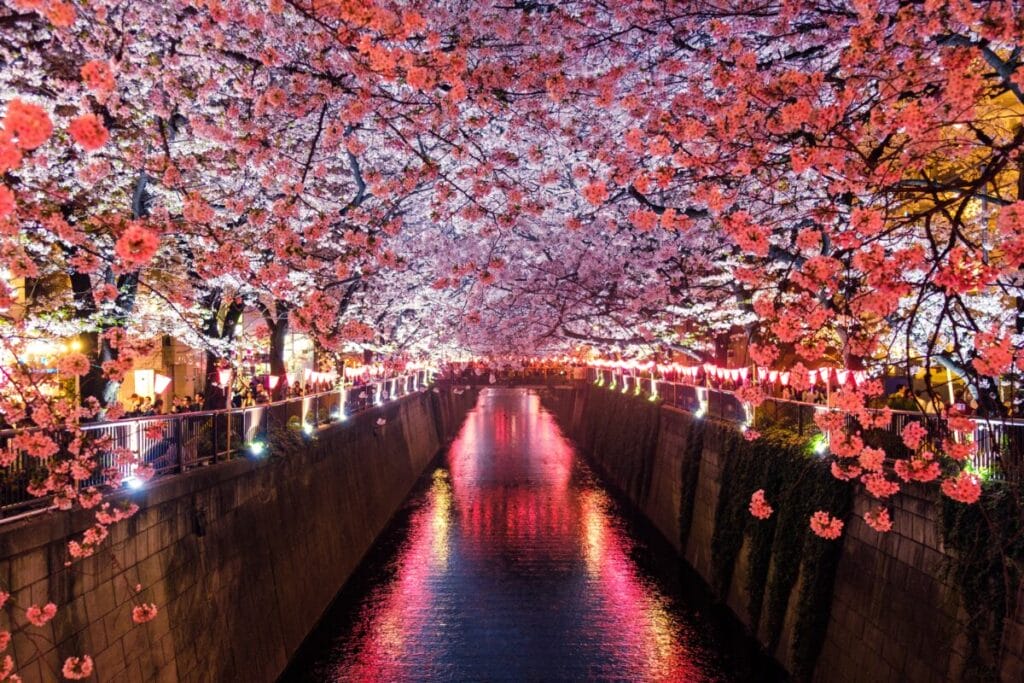
Flowers are integral to Japanese culture and symbolism, in part because each flower has specific attributes. Flower motifs are common throughout Japan and you’ll see them decorating everything from traditional clothing to earthenware and ceramics. It is said that kami, Shinto spirits, live inside the ancient flowering trees, called kodama. Just one more reason to protect and revere this natural wonder. There is even a goddess dedicated to flowers named Konohanasakuya-hime, specifically cherry blossoms, as well as Mt. Fuji.
Japan has a language of flowers, called hanakotoba, that refers to the fact that each flower has a specific meaning. The term hanakotoba truly embodies the Japanese reverence for flowers and translates to other terms like ikebana, or the art of flower arrangements. Flower arranging is an artform in Japan and the cross section of hanakotoba and ikebana can be communicated with a simple bouquet.
Flower viewing is an essential cultural experience in Japan for visitors and since it takes place for much of the year, in one way or another, there’s no reason to miss it! Here’s your guide to hanami in Japan.
Cherry Blossoms
The first flowers that most likely come to mind when thinking about Japan are the iconic cherry blossoms, or sakura, blooming in a blaze of pink and white at the beginning of March and throughout the month of April. Sakura are the most important flower in Japan and represent ideals like renewal, hope, and the impermanence of life. Their fleeting nature causes onlookers to reflect on how brief each moment is and inspires gratitude.
Best time to view Cherry Blossom: March to April
There are over 20 different varieties of sakura in Japan, the most popular being the somei yoshino, a variety with five petals, light pink hue, and no leaves. Yama zakura, or mountain cherries, are much like the somei yoshino but their leaves appear at the same time. The exquisitely beautiful shidare zakura, or weeping willow cherry, are Kyoto’s city flower and have inspired poems and songs for centuries. Rarer varieties also occur like the yae zakura, a cherry blossom that can have up to fifty petals on each flower! This variety only grows on the Izu Peninsula and ranges from stark white to deep pink.

Cherry Blossom in full bloom. Nakameguro Park, Toyko
Some of the most popular destinations for cherry blossom viewing include the idyllic Himeji Castle, Lake Kawaguchiko, Hirosaki Castle, and Mount Yoshino. Tokyo’s best viewing takes place in Nakameguro and Yoyogi Park. While hanami parties by day are astonishing, attending a yozakura, or night sakura viewing, truly takes the experience to the next level! Lights are strung and arranged throughout the sakura to highlight their beauty and provide a magical atmosphere to enjoy them. Lay out a picnic blanket beneath the fragrant, dainty blossoms and partake in the convivial atmosphere as thousands of locals come out to appreciate and admire the sakura.
Be sure to look at the “flower forecast” ahead of time to see when Japan is predicting the bloom will be at its peak. The forecast is usually released a few months in advance, helping you prepare to arrive in Japan at the perfect time!
What to pack for Japan: ultimate Japan packing list
Plum Blossoms
While many think that cherry blossoms are the first harbingers of spring, it is actually the humble plum blossom that ushers in the new season. Plum blossoms were the first flower craze in Japan. Cherry blossom appreciation didn’t begin until the Heian Period, from 794 to 1185 CE.
Best time to view Plum Blossoms: Mid-February to Mid-March
Plum blossom hanami is a great way to beat the crowds and get off the beaten path while still enjoying a stunning natural phenomenon. Ume blossom earlier than sakura, typically from mid-February to mid-March, and provide a more under-the-radar option for visitors who don’t want to fight the crowds of the high cherry blossom season. They’re also said to be much more fragrant than sakura, their sumptuous scent wafting along the late winter breeze.

Japanese plum blossoms are a symbol of perseverance and purity as they are the first signs of spring. What some visitors don’t know is that there are different varieties of plum blossoms that vary in color and number of petals. Plum blossom varieties are similar to the different cherry blossoms in that they are distinguished by how many petals they have. The earliest trees can start blooming in December. Talk about early birds! The Atami Plum Garden in Shizuoka is thought to be one of the first areas to see the blooms.
The best places to witness the delicate ume are plum blossom festivals, or ume matsuri. The Odawara Ume Matsuri is particularly lively and begins in February. Dine on plum flavored desserts and drinks like Umeshu, or Japanese plum wine, and soak in the phenomenal scenery.
Other Spring Flowers
Spring doesn’t just usher in the famed plum and cherry blossoms but myriad other floral delights. Wisteria hangs in delicate tendrils, forming romantic tunnels to walk beneath, while the azaleas are a flush of color in April. Tulips have also become a popular spring spectacle due to their Dutch counterparts fame.
Best Viewing Times
Azaleas: Early April to Early May
Tulips: March to April
Wisteria: Mid-April to late May
From early April to early May, azaleas “tsutsuji” burst into a plethora of colors. The Bunkyo Azalea Festival is particularly impressive with over 100 species of azalea cultivated in 300-year-old gardens. The Shiofune Kannonji Azalea Festival is also a great gathering to attend if you’re a lover of astonishingly colorful florals.
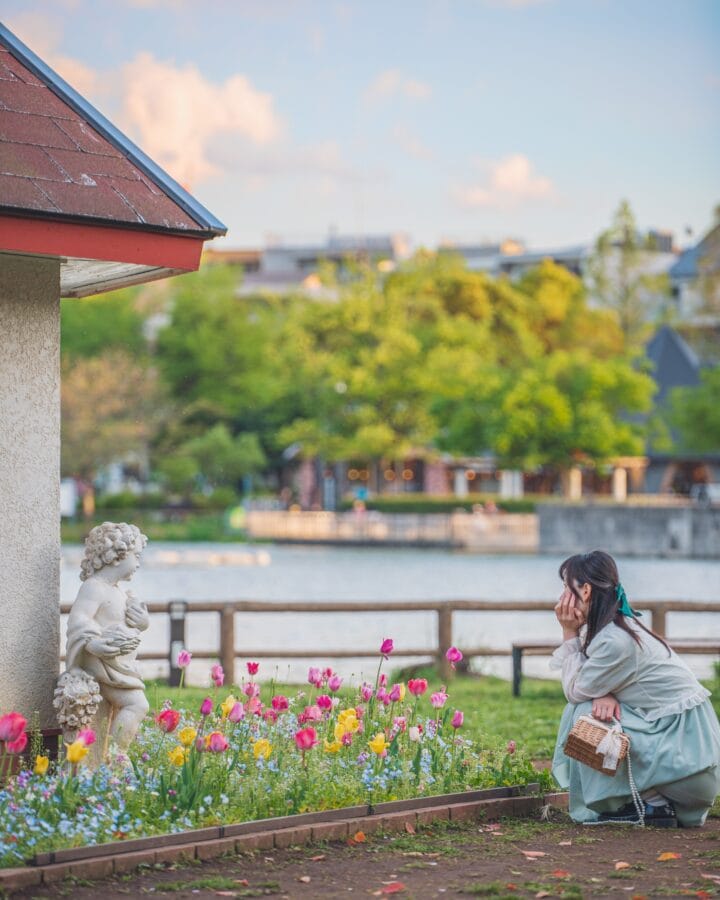
Ukima Park, Tokyo is an ideal spot for tulips
Tulips have grown in popularity in Japan alongside the fame of Dutch tulip festivals. Japan’s climate makes for perfect tulip growing conditions and they started being cultivated here in the 1950’s. From March to April, the countryside is streaked with vibrant colors at tulip parks. Kamiyubetsu Tulip Park in Hokkaido is one of the best and oldest places to witness tulips in the Land of the Rising Sun. Hokkaido also grows lavender and is famous for its Irodori Fields, awash in a kaleidoscope of stripes.Tonami Tulip Park and Hitachi Seaside Park are great viewing sites.
Wisteria is a particularly magical addition to your spring hanami itinerary, growing in purple tendrils towards the ground and creating tunnels of lavender hues along picturesque pathways. Wisteria season is just after the cherry blossom season, from mid-April to late May. Kawachi Wisteria Garden and Byakugou-ji Temple are two excellent places to see these amethyst petals but the true pinnacle of wisteria viewing is at the Great Wisteria Festival, held every April and May in Ashikaga, only two hours from Tokyo.
Summer Flowers
Japanese summers bring warm weather and heavy rains, two crucial ingredients for boisterous blooms. From fields of lazy-headed sunflowers, reaching as far as the eye can see, to bulbous hydrangeas busheled in a cluster of indigo petals, summer makes it clear that spring isn’t the only time for hanami in Japan!
Best Viewing Times
Sunflowers: June to July
Hydrangeas: June to July
Lotus: Mid-July to mid-August
The most popular flowers to seek out in Japan’s summer months are sunflowers, hydrangeas, and lotus. Sunflowers, called himawari in Japanese, bloom from mid-July to mid-August in a veritable ocean of mustard colored petals. The best places to get an iconic picture in this sea of flowers is at one of the dedicated sunflower fields like the Hokuryo Sunflower Village, one of the largest in Japan, or the Nanko Sunflower Field.
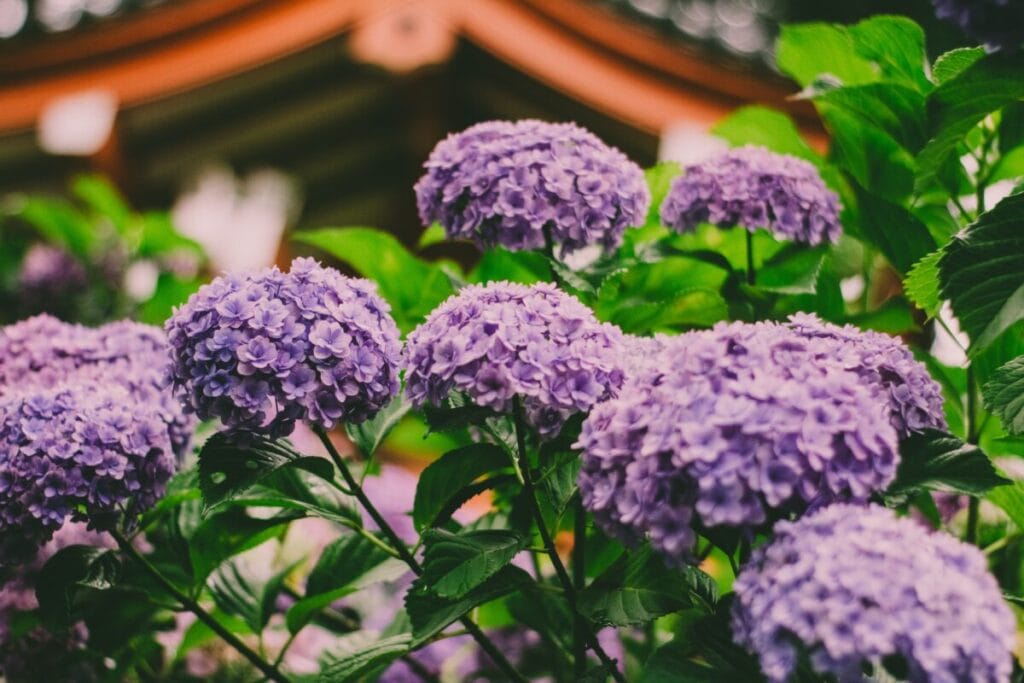
Mimuroto-ji Temple, Uji-Shi, Japan
Some of the most beautiful summer flowers to admire are hydrangeas. Also known as ajisai, hydrangeas bloom from June to July and range in color from white to pink to brilliant blue. One of the best places to witness their sapphire glory is at the Unsho-ji Temple in Oga where hydrangea cultivation is taken seriously. With over 1,200 blooms to admire, you could spend days wading through these botanical beauties. Another great place to see hydrangeas in Japan is at Takahata Fudoson Temple in the heart of Tokyo or at the Shimoda Hydrangea Festival.
Last but not least, idyllic hasu, or lotus flowers dot the ponds and lakes that surround Japan’s temples and shrines. Lotus season is typically from mid-July to mid-August. These stark white blooms, symbolizing enlightenment and purity, are best viewed at the Karako Lotus Gardens in Nagasaki, Mimurotoji Temple in Kyoto, or the Shinobazu Pond in Tokyo.
Autumn Flowers
The start of autumn in Japan ushers in perhaps the second most popular natural spectacle in the country, leaf viewing. Known as momijari in Japanese, locals have been tracking down the ombre sunset of maple leaves for hundreds of centuries. It’s also the perfect time to look for chrysanthemums and cosmos, two other botanical autumn joys that are important to Japanese culture.
Best Viewing Times
Chrysanthemums: September to November
Cosmos: October
Maples: Mid-October to mid-December
Chrysanthemums are one of the most popular flowers in Japan and represent “longevity and rejuvenation”. They are used as a symbol of the Japanese royal family and are imprinted on the royal seal, 50 yen coins, and passports, showing that they are an important cultural icon to the people of Japan. You can catch these delicate buds from September to November as they love cooler weather. The Meiji Shrine and Sensoji Temple are two of the best places to see…
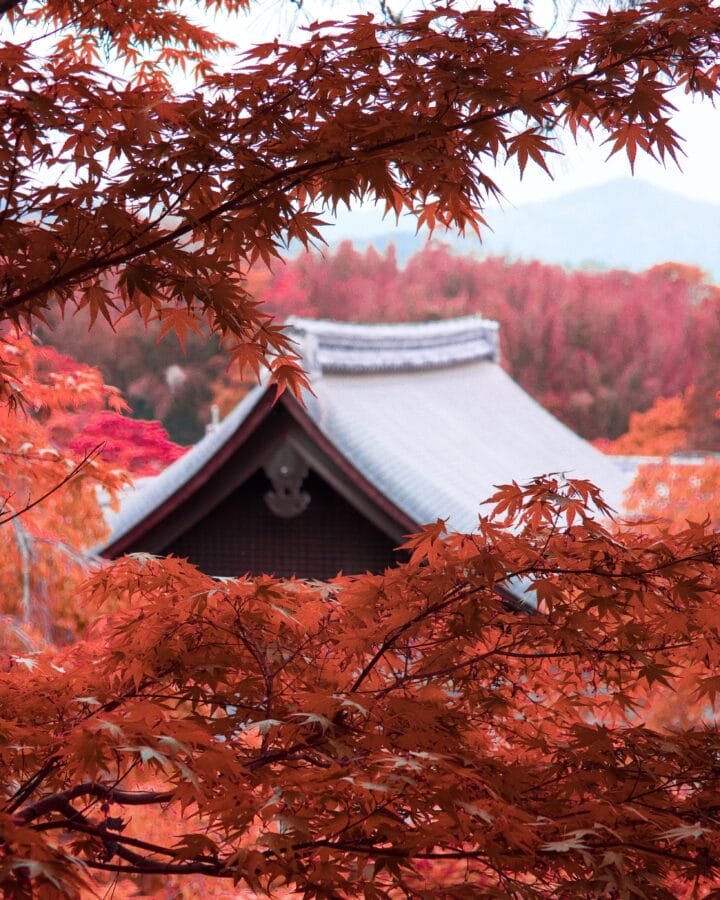
Kyoto, Japan
Cosmos, akizakura in Japanese, are known as the “fall cherry blossoms”. These flowers bloom throughout the month of October in shades of pink, red, and white. The Kirin Factory Cosmo Fields are a great place to stop and smell the cosmos and grab a beer while you’re at it! Showa Kinen Park in Tokyo is also a beautiful park to seek out these blooms.
The star of the show in autumn though are the maples of course! These fiery fronds begin changing color in mid-October and last through early December but peak is typically at the end of November. This can range dramatically though as trees in Japan’s northern reaches, like Hokkaido, start to change earlier than those in the south. The most impressive areas to see the autumn blaze are Lake Towada, Tofukuji Temple in Kyoto, and Koishikawa Korakuen.
Japanese culture has long been known for its appreciation of beautiful things, and this is one of them. Jump on the Shinkansen and speed through the countryside to seek out under-the-radar blooms or join the hordes in the city centers, gathering in appreciation of these stunning blossoms, either way you’ll be spoiled for choice when it comes to Japanese hanami.
If it’s not already obvious, witnessing any form of hanami is a cultural delight on a trip through Japan and a compliment to the already stunning natural scenery and well-manicured historical sites you’re bound to see. There’s truly nothing like experiencing the rush and conviviality of hanami in the Land of the Rising Sun.
